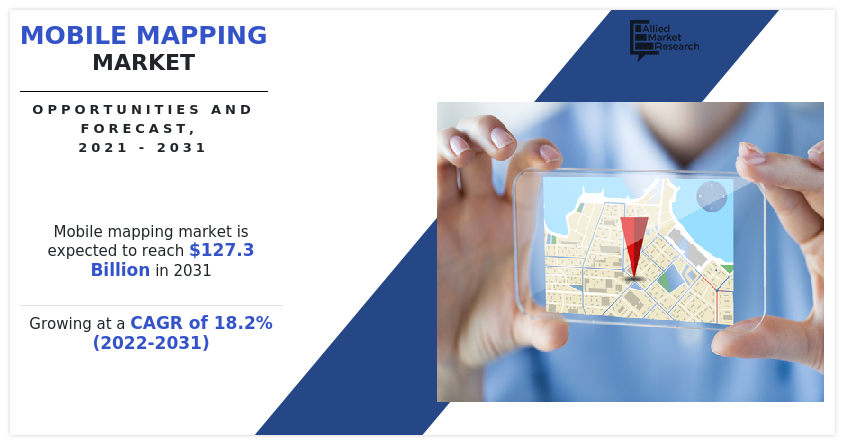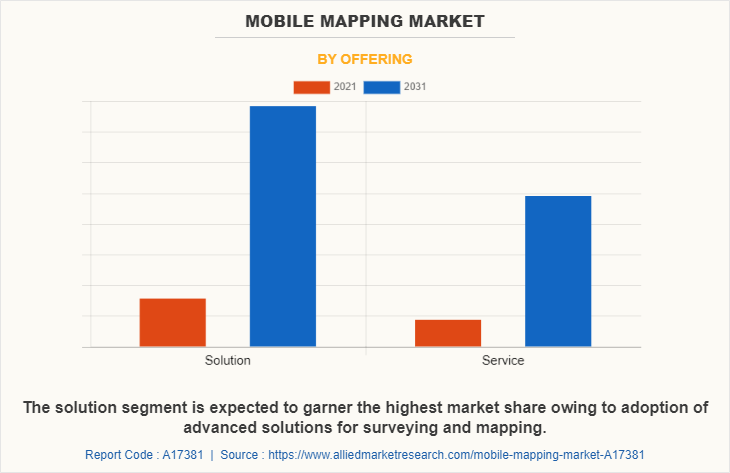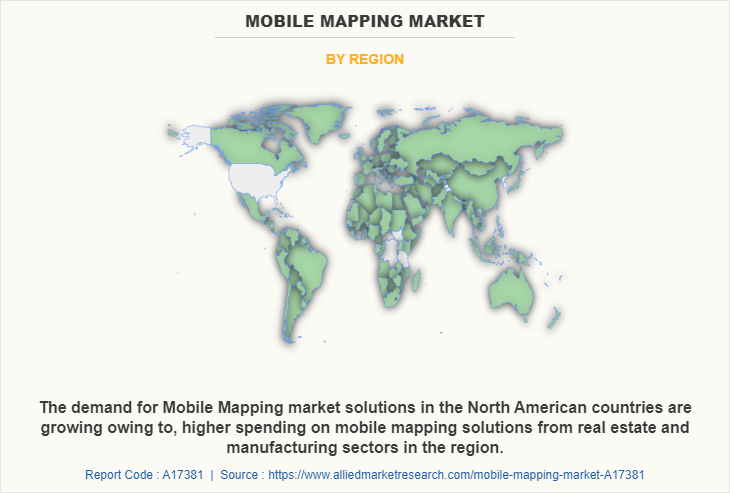Mobile Mapping Market Research, 2031
The global mobile mapping market was valued at $24.2 billion in 2021, and is projected to reach $127.3 billion by 2031, growing at a CAGR of 18.2% from 2022 to 2031.
Mobile mapping is the process of collecting geospatial data from a mobile vehicle, typically fitted with a range of GNSS, photographic, radar, laser, LiDAR or any number of remote sensing systems. The Mobile Mapping Softwaresystems are composed of an integrated array of time synchronized navigation sensors and imaging sensors mounted on a mobile platform. The primary output from such systems includes GIS data, digital maps, and georeferenced images and video. The enquiries on Geo-matching, ranging from major organizations such as NASA to small surveying companies worldwide is one the factor boosting mobile mapping industry. As per AMR study, the number of mobile mapping systems on Geo-matching has grown with a stunning 325% in last three years.
The rapid adoption of satellite mapping technology and its seamless integration into smartphones and Internet of Things (IoT) connected devices are driving Mobile Mapping Market Growth. Moreover, the surge in application of the global navigation satellite system (GNSS) in 3D mapping, environmental monitoring, machinery control, accident investigation, and disaster response to the need for accurate and up-to-date spatial data has created demand for the mobile mapping market. In addition, the mobile mapping market is promoting the development of new approaches for automated and fast data collection with the help of the latest 5G internet. However, privacy & data security apprehensions and high cost of implementation of mobile mapping solution have hampered the market growth. Furthermore, mobile mapping integration with wearable smart devices and growth of mapping analytics are likely to provide lucrative development opportunities for the mobile mapping market during the forecasted period.

The mobile mapping market is segmented into Offering, Deployment Model, Enterprise Size, Application and Industry Vertical. On the basis of offering, the market is segmented into solutions and services. Depending on solutions, the market is divided into hardware and software. Depending on hardware, the market is bifurcated into handheld devices and wearable devices. According to organization size, it is fragmented into large enterprises and SMEs. On the basis of deployment, the market is classified into cloud and on-premise. Depending on application, the market is segregated into Topographic Mapping, road surveys, 3D modelling, asset management, and others. By industry vertical, the market is segmented into construction & real estate, energy & utilities, transportation & logistics, retail, government & public sector, manufacturing, and others. Region wise, it is analyzed across North America, Europe, Asia-Pacific, and LAMEA
Some of the major players in the market are Microsoft Corporation, Qualcomm Inc., Trimble Inc., Mitsubishi Electric Corporation, Google LLC, Black & Veatch, Apple Inc., Pasco Corporation, GeoSLAM, Leica Geosystems, Hexagon AB, Foursquare Labs, Novatel Inc, Javad GNSS Inc., Teledyne Optech LLC, EveryScape Inc., and MapJack.

On the basis of offering, the solution segment dominated the Mobile Mapping Market Share in 2021, and is expected to maintain its dominance during the forecast period due to adoption of advanced Mobile Mapping Software solutions for surveying and mapping and increase in use of geospatial data. However, services segment registered highest growth rate during the forecast period due to increase in the adoption of mobile mapping services among end users, as they ensure effective functioning of solutions and platforms throughout the mapping process.

Region wise, the Mobile Mapping Market Size was dominated by North America in 2021, and is expected to retain its position during the forecast period. This is attributed to number of factors such as adoption of mobile mapping among various verticals such as manufacturing and real estate and digitalization across the region. In addition, presence of growing number of mobile mapping vendors across the U.S. and Canada is expected to provide lucrative opportunities for the market. However, Asia-Pacific is expected to witness significant growth during the Mobile Mapping Market Forecast period, owing to wide presence of small-and medium-scale organizations and presence of mobile device manufacturers in the region.
COVID-19 Impact Analysis
During the COVID-19, Mobile Mapping Industry has played a crucial role in acquiring the travel history and location of affected persons. Governments are increasingly using mobile mapping tools to map demographic data and correlate it with spread of the disease distribution in a particular area. So, the pandemic has had a positive impact on the mobile mapping market. In addition, the pandemic has had a significant impact on hardware manufacturers due to disruptions in the supply chain and government-imposed restrictions.
Top impacting factors
Factors such as growth in demand for accurate land-based maps and growing investments in smart city projects impact growth of the mobile mapping globally. in addition, the market growth is affected by high initial investment. furthermore, emergence of automated driving technology influences the market growth. However, each of these factors is anticipated to have a definite impact on growth of the global mobile mapping during the forecast period.
Growing investments in smart city projects
Digitization of urban infrastructure, planning and optimization of resources are the basis of smart cities and digital strategies are the key to successful transformation. Many smart city projects are underway, expanding the landscape of urban development with urban digitalization and information and communication technology. For smart city projects, spatial data serves as a basis for urban development planning. It contains detailed ground information in the form of mixed reality 3D maps and models. To create and manage smart cities and act as a source of income for city managers, organizations need a reliable and accurate spatial database. For instance, the city of Amsterdam used the Trimble MX7 mobile mapping system for smart city implementation.
Emergence of automated driving technology
The expansion of autonomous connected vehicle infrastructure is due to rising consumer expectations and various technological advancements. In poor visibility and conditions, the mobile mapping system helps plan the vehicle and provides a safety net of sensors to make autonomous driving safer. Automation can greatly improve the comfort of the driver by considering the difficulties of driving. Autonomous driving needs mobile mapping solutions of highest order. So, the emergence of autonomous driving technology is providing ample growth opportunities for market growth.
Key Benefits For Stakeholders
- This report provides a quantitative analysis of the market segments, current trends, estimations, and dynamics of the mobile mapping market analysis from 2021 to 2031 to identify the prevailing mobile mapping market opportunities.
- The market research is offered along with information related to key drivers, restraints, and opportunities.
- Porter's five forces analysis highlights the potency of buyers and suppliers to enable stakeholders make profit-oriented business decisions and strengthen their supplier-buyer network.
- In-depth analysis of the mobile mapping market segmentation assists to determine the prevailing market opportunities.
- Major countries in each region are mapped according to their revenue contribution to the global market.
- Market player positioning facilitates benchmarking and provides a clear understanding of the present position of the market players.
- The report includes the analysis of the regional as well as global mobile mapping market trends, key players, market segments, application areas, and market growth strategies.
Mobile Mapping Market Report Highlights
| Aspects | Details |
| By Offering |
|
| By Deployment Model |
|
| By Enterprise Size |
|
| By Application |
|
| By Industry Vertical |
|
| By Region |
|
| Key Market Players | Hexagon AB, Javad GNSS Inc., Mitsubishi Electric Corporation, Black & Veatch, Qualcomm Inc., Optech LLC, Microsoft Corporation, Leica Geosystems, Apple Inc., MapJack, Trimble Inc., Pasco Corporation, EveryScape Inc., Google LLC, Foursquare Labs, GeoSLAM, Novatel Inc |
Analyst Review
The global Mobile mapping market is projected to witness prominent growth, especially in Asia-Pacific and North America. This growth is attributed to increased investments by organizations and governments for automation and adoption of cloud-based Mobile mapping solutions. In addition, adoption of location-based devices globally provides ample growth opportunities for mobile mapping solutions. The current business scenario has witnessed increase in adoption of mobile mapping solutions in developed as well as developing regions as mobile mapping solutions in government and public sector maximizes efficiency by providing geo-location details for smart city implementation and also provides details of routes and surveys for better infrastructure development.
Moreover, enterprises make significant investments in R&D to enhance their existing solutions and deliver new solutions as well as develop new machine intelligence and automation technologies. For instance, in December 2021, Microsoft teamed up with Airbus, an aerospace corporation. Following this collaboration, Airbus announced the launch of premium satellite imagery and elevation data in Microsoft Azure Maps. The users of Azure Maps have the access to a new global reference layer developed from high-quality Airbus imagery and a homogenous elevation dataset covering the world.
Prominent market players are exploring new technologies and platforms to meet increase in customer demands. Product launches, partnerships, and acquisitions are expected to enable them to expand their product portfolios and penetrate different regions. For instance, in October 2021, TomTom extended its partnership with Precisely, the data integrity company. Under this expansion, TomTom aims to continue to offer map and traffic data for location intelligence solutions delivered by Precisely. Moreover, precisely utilizes TomTom's data as part of its data enrichment offerings. These offerings are leveraged by organizations throughout a wide range of industries for various purposes.
Asia-Pacific exhibits the highest adoption of Mobile mapping solutions. On the other hand, LAMEA is expected to grow at a significant growth rate, predicting a lucrative market growth for Mobile mapping solutions, especially in countries such as Brazil, South Africa, and UAE.
The global mobile mapping market was valued at $24,187.42 million in 2021, and is projected to reach $127,281.45 million by 2031, registering a CAGR of 18.2% from 2022 to 2031.
North America dominated the global market in 2021
The topographic mapping segment is expected to garner the highest market share.
Emergence of automated driving technology provides ample growth opportunities for mobile mapping market
Some of the major players in the market are Microsoft Corporation, Qualcomm Inc., Trimble Inc., Mitsubishi Electric Corporation, Google LLC, Black & Veatch, Apple Inc., Pasco Corporation, GeoSLAM, Leica Geosystems, Hexagon AB, Foursquare Labs, Novatel Inc, Javad GNSS Inc., Teledyne Optech LLC, EveryScape Inc., and MapJack.
Loading Table Of Content...


